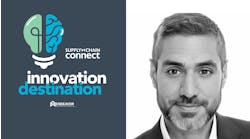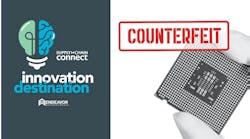How has the electronic components industry ended up at the close of 2023 and what is in store for 2024? Mike Slater, Vice President of Global Business Development at DigiKey, joins this Innovation Destination Executive Perspectives episode to discuss what procurement professionals can anticipate in the coming months and the tools and technologies available to be leveraged for successful operations.
This interview was edited and formatted for clarity.
Tyler Fussner, Managing Editor, Supply Chain Connect
Mike, thank you for joining us today.
Mike Slater, Vice President of Global Business Development, DigiKey
Good morning, Tyler. Thank you for having me.
Fussner
Could you please introduce yourself to our audience?
Slater 0:29
I’m Mike Slater. I’m the Vice President of Global Business Development for DigiKey. I have been in the business for over 25 years and in distribution mainly. I’m happy to be talking today about some topics that I think are near and dear to all our hearts.
Fussner 0:47
Absolutely. And thank you, again, for sitting down and taking the time. I wanted to start our discussion by asking you to give us a pulse reading of the market. How does the market seem to be closing in 2023? Where do you think we’re going to land by the end of the year?
Slater 1:02
It’s certainly something we’ve talked about a lot throughout the year and going into 2023. DigiKey experienced unprecedented sales in 2020 through 2022. And we did see and expected a cooling in the market for 2023. Consistent with down cycles that we’ve seen in the past, we saw a bit of a decline in revenue. And we look at things based on average order value, so a little differently than some folks, but that’s some of the things we look at.
From a business perspective, things that drive our business and some of the fundamentals are around customer count and actual shipments. While, overall, in 2023 the supply chain is improved. Inventory is more readily available and there are semiconductors, some in particular, that are still in short demand. I mentioned earlier customer count and shipments; we are seeing positive signs for both new customers and design activity in 2023. At the end of the year here, we’re seeing demand in certain pockets starting to pick up as the year winds down. But overall, the industry is certainly slower in 2023 than it was in 2022 and earlier, but there are really positive signs for 2024. And we do expect to see growth in 2024, especially as the year progresses.
Fussner 2:24
And that’s exactly what I wanted to ask you, Mike. Coming out of 2023 and looking into 2024, what should stakeholders anticipate in, say, the first six months? The next 12 months?
Slater 2:36
We viewed 2023, I mentioned this earlier, we viewed it as an expected year that we would see a little bit of a pause. We took that as a year to invest and prepare for the next cycle of future growth. We look forward to continued growth in 2024. Especially in the second half of the year.
In-stock trends, the available inventory that we have, continues to improve. New customers are coming to us at a very high rate. Design activity has been really solid for quite some time. That gives us a ton of optimism for how 2024 and beyond will look.
Fussner 3:12
And as it relates to the electronic components industry specifically, do you see any certain verticals that are more poised for growth in 2024? And conversely, any certain verticals that maybe could see a reduction in activity?
Slater 3:29
2024—it’s going to be a year of innovation and new customers. DigiKey is really pleased to help support the new push for new product launches. I would say wireless connectivity, industrial automation, electrification, smart sensors, rapid prototyping—those are all key driving trends that we see that we touch every day.
I don’t have a crystal ball. We talk about this a lot for what we’re expecting as far as specifics in the market for 2024, but we do expect to get back to growth for the overall electronics industry. And as I mentioned, we believe we’ve really worked hard in 2023 to set ourselves up to quite honestly outperform the market in 2024.
You asked about certain verticals that might see a reduction in activity. There’s been a surge of new product introductions targeted at every industry. 2020 to 2022, suppliers were really focused on driving and taking care of the demand that they had, so we didn’t see as many new product introductions as we had in previous years. But that accelerated in 2023 and we really think it’s going to continue to accelerate in 2024. That fits us and our customers very well. These new product introductions will drive our customer count and general business across the board.
I don’t know that there’s anything that I would say that we’re going to see a reduction in activity, because there’s just so much innovation and so much new product introductions really targeted at every industry. We see that really accelerating the progress and the business for engineers and designers in all areas.
Fussner 5:08
And if the industry is to expect some more innovation and growth, I want to ask your perspective on how procurement professionals in the electronic space can really prepare for next year. What should be atop their priority list in order to be more strategic and proactive in the new year?
Slater 5:26
Most electronic components and automation products, they’re more plentiful than they had been in 2021 or 2022. But I think it’s a really good time to identify alternative parts through tools like DigiKey’s myList and other online solutions that we have. I don’t think it’s a good idea to wait until it’s crunch time or there’s another supply chain issue to start to prepare for what we know is pretty much inevitable in the future. This business is cyclical in nature. And with the proliferation of electronics in everything, we know we will see demand at levels above supply in the future. So, now’s the time to prepare for when that supply is short. Get yourself ready for that next cycle.
Fussner 6:10
You touched on some digital tools that are available and that leads to my next question. What are some major trends that are in the procurement space today? And do you see certain trends surging or becoming even more relevant in 2024?
Slater 6:27
In the past (I mentioned cycles a couple of times and the business cycles) but what we’ve seen in past cycles in the electronics business, or when suppliers merge, or there’s acquisitions, companies look at the redundancy in technology and their components. And there’s probably going to be more end of life and last time by solutions than there have been over the last few years. That significantly impacts the supply chain overall. It impacts procurement. We’ve seen this in waves in the past during different parts of cycles. That, along with the lifecycle of our technology, is really becoming shorter as time goes on. That makes it more complex for our customers and procurement. I would say I’d be aware of that trend. I’d be making myself ready for potential changes in technology or last time buys than you have seen in the last few years.
Fussner 7:22
And is there any way that procurement teams can set themselves up for success to be able to anticipate and execute on those trends?
Slater 7:30
Yeah, for sure. When designers are working on innovation, it’s critical to ensure that they’re working with products that are widely available and in stock. We can certainly help guide that with all the information that we have on our website. It’s really good to incorporate second source options, when available, from the beginning. I would encourage that from the initial design all the way through to when procurement folks are trying to find alternatives to supply challenges. But limiting those risks when you’re working through the bill of materials is definitely critical.
Fussner 8:07
Now, on the flip side, are there any trends or maybe outdated practices that procurement teams need to leave behind in 2023?
Slater 8:18
I don’t know about leaving behind the trends in 2023 that are outdated, but I would say that we should all embrace change and look for new ways to solve problems and leverage technology. Things that have worked well in 2023 or even five years ago have different solutions today or could be handled much more efficiently. I would take time to identify what’s slowing you down and what’s holding you back today and work to change and put in solutions or technology that can help leapfrog you forward.
One example I’ll use is the leveraging of APIs. We have an API that can help you with availability, quoting and ordering. That API solution connects to our myLists online; that helps ensure a clean and up to date bill of materials. They can get all the procurement data they need, quickly, easily put this into a CSV file, saving time and energy so that they can work on other things.
I would say that not necessarily leave something behind but be open for change and be out looking for how to do things more efficiently and differently than you have been in the past.
Fussner 9:29
I think that’s a good New Year’s resolution to take into 2024. Be open to change and be open to trying some new things; make sure that you are creating efficiencies in your processes.
Mike, I have one more question for you. How can DigiKey help procurement professionals succeed in 2024?
Slater 9:49
DigiKey can help procurement professionals by embracing technology with many of the data-focused tools that we have on our website, and these are free tools that we have on our website: conversion calculators, cross reference capabilities, tech forum, reference design libraries, data sheets parametric information for components… and so much more. We are focused on providing our customers with everything that they need online, immediately, so that they can access the information and tools whenever they need them, making their business move faster and ultimately their lives much easier.
That’s something I would say to help procurement professionals; go out and see all the tools and technology we have online, for free, to use and figure out a way to help you leverage that.
Fussner 10:39
Mike, thank you again for sitting down and joining us today. We really appreciate your perspective.
Slater 10:45
Thank you for having us, Tyler. We’re thrilled to be able to help designers and procurement professionals everywhere around the world to make their lives easier.









